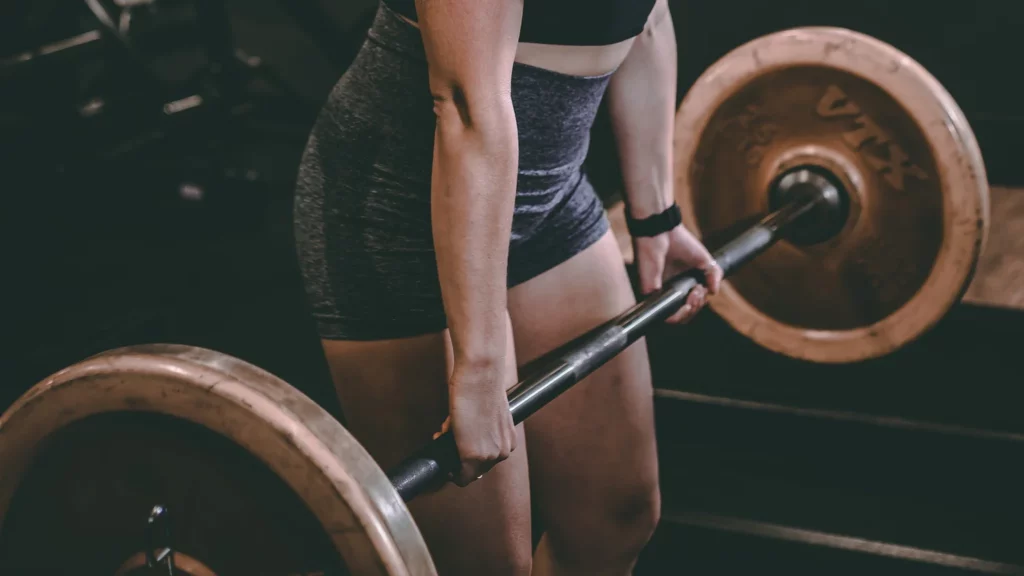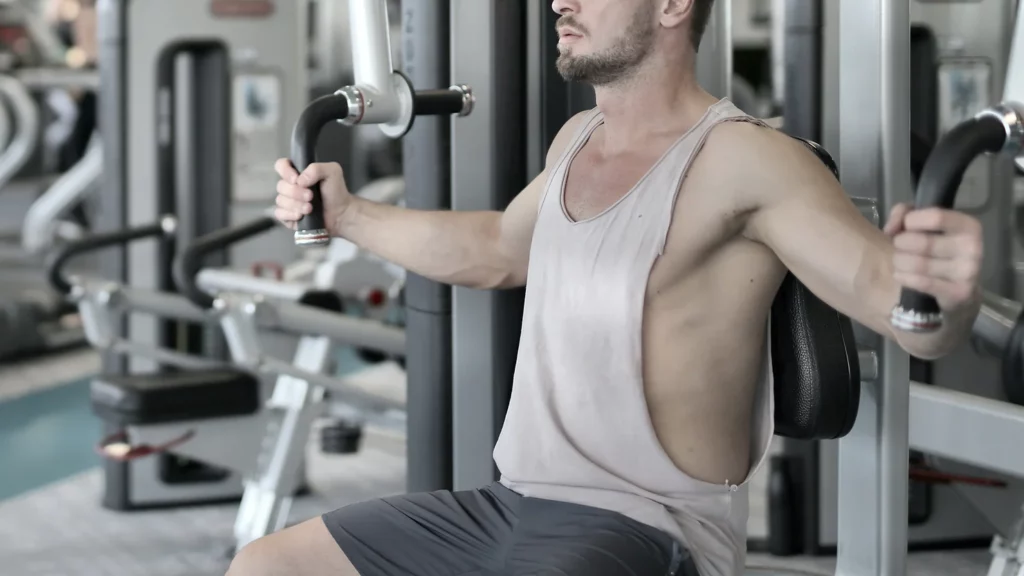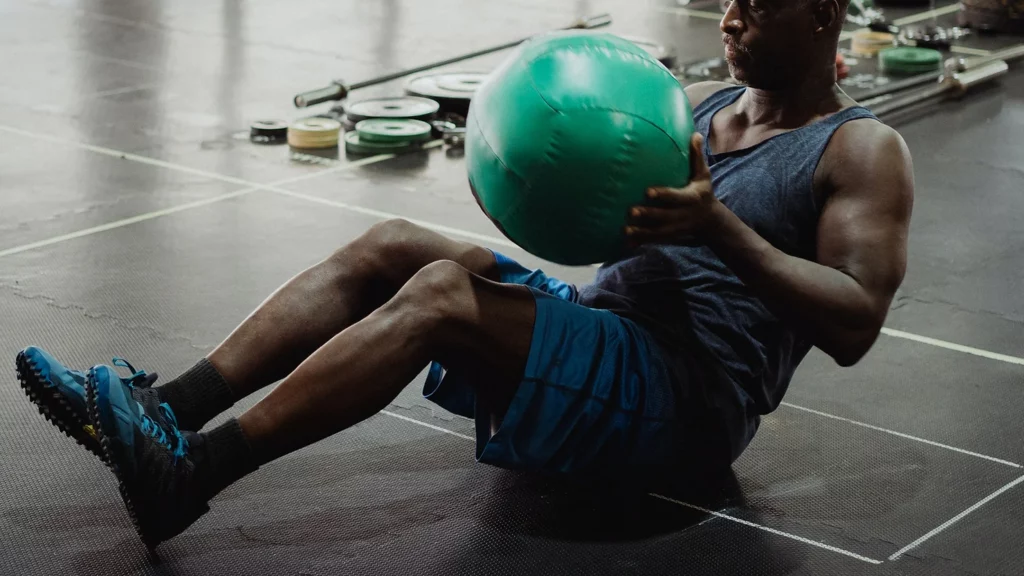Before we dive in: check out our full-body training program to develop a strong body and aesthetic physique; you will benefit from one of our programs. We designed a program that gives you the tools to build muscle with an easy-to-follow routine that will fit any schedule. To find out more:
The Benefits of the Rack Pull
The rack pull is a compound exercise, meaning it works multiple muscle groups at once. This makes the rack pull an efficient way to build muscle and strength. Specifically, the rack pull exercises the posterior chain. The posterior chain is a group of muscles in the back of the body that are responsible for a wide range of motions. These muscles include the hamstrings, glutes, and lower back. The rack pull is a great exercise for targeting these muscles. These muscles are often neglected and underused due to the modern sedentary lifestyle. As a result, many people have weak and underdeveloped posterior chains. The rack pull is a great exercise for building strength in these muscles. The rack pull is also a great exercise for developing grip strength. The exercise requires you to grip the bar tightly in order to lift it, which can help to develop your forearm and grip strength.
How To Perform the Rack Pull
There are a few things to keep in mind when performing the rack pull. First, it is important to use proper form. This means keeping your back straight and avoiding rounding your lower back. Second, it is important to grip the bar tightly with an overhand grip. You can also use an underhand grip if you prefer. Third, it is important to pull the bar up with your legs, not your lower back. This will help to avoid injury and ensure that you are targeting the correct muscles. Finally, it is important to keep the bar close to your body throughout the entire exercise.
To perform this exercise:
-
Start by setting the bar up at about knee level on the squat rack guard handles.
-
Place your feet about shoulder-width apart and grip the bar with an overhand grip.
-
Bend your knees and hips to lower your body down to the bar.
-
Keeping your back straight, drive your legs through to a standing position, pulling the bar up along your body.
-
Reverse the motion to lower the bar back down to knee level and repeat.
Variations of the Rack Pull
There are a few variations of the rack pull that you can try. First, you can try using an underhand grip. This will target your muscles differently and may be more comfortable for some people. Second, you can try using Resistance Bands. These are a great option if you don’t have access to weights or a squat rack
Alternatives of the Rack Pull
The rack pull is a great exercise, but it’s not the only option when it comes to training your posterior chain. Here are a few alternative exercises that you can try:
Exercise #1: Deadlift
The deadlift is a compound exercise that targets the same muscle groups as the rack pull. The deadlift is a great exercise for building strength and size in the posterior chain.
To perform this exercise:
-
Start by standing with your feet about shoulder-width apart and your knees slightly bent.
-
Bend down and grip the bar with an overhand grip.
-
Keeping your back straight, drive your legs through to lift the bar up off the ground.
-
Reverse the motion to lower the bar back down to the ground and repeat.
Common Mistakes
There are a few common mistakes that people make when performing the rack pull. First, some people round their lower back when they pull the bar up. This can lead to injury and is not recommended. Second, some people use too much weight. It is important to use a weight that you can handle with good form. Third, some people pull the bar up with their lower back instead of their legs. This can also lead to injury and is not recommended.
Exercise #2: Glute Bridge
The glute bridge is a great exercise for targeting the glutes and hamstrings. The exercise can be performed with or without weight.
To perform this exercise:
-
Start by lying on your back with your feet flat on the ground and your knees bent.
-
Place your hands on the ground beside you.
-
Press through your heels to lift your hips off the ground.
-
Hold for a moment at the top of the movement and then lower your hips back down to the starting position.
Common Mistakes
There are a few common mistakes that people make when performing the glute bridge. First, some people allow their knees to collapse inward during the exercise. This puts unnecessary stress on the knees and can lead to injury. Second, some people arch their back during the exercise. This can also lead to injury. It is important to keep your back flat throughout the entire movement.
Exercise #3: Hamstring Curl
The hamstring curl is a great exercise for targeting the hamstrings.
To perform this exercise:
-
Adjust the machine so that the pad is in line with your knees.
-
Lie face down on the machine and position your ankles under the pads.
-
Curl your legs up towards your glutes, and then lower them back down to the starting position.
Common Mistakes
There are a few common mistakes that people make when performing the hamstring curl. First, some people use too much weight. It is important to use a weight that you can handle with good form. Second, some people allow their hips to rise off the bench during the exercise. This takes the focus off of the hamstrings and puts unnecessary stress on the lower back. Third, some people curl their legs up too high. This can place unnecessary stress on the knees and is not necessary to get a good hamstring workout.
Exercise #4: Swiss Ball Hamstring Curl
The Swiss ball hamstring curl is a great exercise for targeting the hamstrings. The exercise can be performed with or without weight.
To perform this exercise:
-
Position a Swiss ball at your feet before lying down on your back with your palms flat on the floor.
-
Place your heels on top of the ball, then press your hips and glutes off the floor.
-
Dig your heels into the ball as you curl it toward your glutes.
-
Reverse the motion, press the Swiss ball away from your glutes to the start position, and repeat.
Common Mistakes
There are a few common mistakes that people make when performing the Swiss ball hamstring curl. First, some people allow their hips to rise off the floor during the exercise. This takes the focus off of the hamstrings and puts unnecessary stress on the lower back. Second, some people curl the ball up too high. This can place unnecessary stress on the knees and is not necessary to get a good hamstring workout. Third, some people use too much weight. It is important to use a weight that you can handle with good form.
Exercise #5: Reverse Lunge
The reverse lunge is a great exercise for targeting the quads, glutes, and hamstrings. The exercise can be performed with or without weight.
To perform this exercise:
-
Start by standing with your feet hip-width apart and your hands at your sides.
-
Step backward with one leg and lower your hips until both knees are bent at 90-degree angles.
-
Push through your front heel to return to the starting position.
-
Repeat with the other leg.
Common Mistakes
There are a few common mistakes that people make when performing the reverse lunge. First, some people allow their knees to collapse inward during the exercise. This puts unnecessary stress on the knees and can lead to injury. Second, some people take too large of a step when performing the lunge. This can also lead to injury. Third, some people do not lower their hips enough during the exercise. This takes the focus off of the quads and glutes and puts unnecessary stress on the knees. It is important to keep your back flat throughout the entire movement.
Exercise #6: Step-Up
The step-up is a great exercise for targeting the quads and glutes. The exercise can be performed with or without weight.
To perform this exercise:
-
Start by standing in front of a bench or box.
-
Place your left foot on the bench and press through your heel to raise yourself up onto the bench.
-
Step down with your left leg and repeat with the right leg.
Common Mistakes
There are a few common mistakes that people make when performing the step-up. First, some people allow their knees to collapse inward during the exercise. This puts unnecessary stress on the knees and can lead to injury. Second, some people take too large of a step when performing the lunge. This can also lead to injury. Third, some people do not raise their hips high enough when they step up onto the bench. This takes the focus off of the quads and glutes and puts unnecessary stress on the knees. It is important to keep your back flat throughout the entire movement.
Exercise #7: Bulgarian Split Squat
The Bulgarian split squat is a great exercise for targeting the quads and glutes. The exercise can be performed with or without weight.
To perform this exercise:
-
Start by standing in front of a bench or box.
-
Place your left foot on the bench behind you and press through your heel to raise yourself up onto the bench.
-
Step down with your left leg and repeat with the right leg.
Common Mistakes
When completing the Bulgarian split squat, there are a few frequent mistakes that individuals make. Second, some people allow their knees to fold in during exercise. This places needless stress on the knees and might result in pain. Second, some people take a large stride when doing the lunge, which can cause harm.
Exercise #8: Hip Thrust
The hip thrust is a great exercise for targeting the glutes. The exercise can be performed with or without weight.
To perform this exercise:
-
Start by sitting on the floor with your back against a bench or box.
-
Place your feet flat on the floor and press through your heels to raise your hips off the ground.
-
Pause at the top of the movement and then lower your hips back to the starting position.
Common Mistakes
There are a few common mistakes that people make when performing the hip thrust. First, some people allow their hips to drop too low during the exercise. This takes the focus off of the glutes and puts unnecessary stress on the lower back. Second, some people do not pause at the top of the movement. This takes away from the time under tension that is needed to build muscle.
Exercise #9: Kettlebell Swing
The kettlebell swing is a great exercise for targeting the posterior chain.
To perform this exercise:
-
Start by standing with your feet shoulder-width apart and a kettlebell in front of you.
-
Hinge at the hips and grab the kettlebell with both hands.
-
Swing the kettlebell back between your legs and then explosively swing it up to chest level.
-
Allow the momentum from the swing to carry the kettlebell back down between your legs and repeat.
Common Mistakes
There are a few common mistakes that people make when performing the kettlebell swing. First, some people allow their lower back to round during the exercise. This puts unnecessary stress on the spine and can lead to injury. Second, some people do not swing the kettlebell high enough. This takes away from the benefits of the exercise.
Exercise #10: Farmer’s Walk
The farmer’s walk is a great exercise for targeting the posterior chain. The exercise can be performed with or without weight.
To perform this exercise:
-
Start by standing with your feet shoulder-width apart and a kettlebell in each hand.
-
Keeping your shoulders down and your core engaged, lift the kettlebells up to chest level.
-
Walk forward while maintaining good posture and repeat.
Common Mistakes
There are a few common mistakes that people make when performing the farmer’s walk. First, some people allow their shoulders to round during the exercise. This puts unnecessary stress on the spine and can lead to injury. Second, some people take too small of steps when walking. This decreases the effectiveness of the exercise.
Summary
Rack pull alternative exercises that we’ve listed are all great for targeting different areas of the body. They can be performed with or without weight and allow you to focus on muscle-building aspects of the exercise. When performing these exercises, it is important to focus on good form and avoid common mistakes. These exercises provide a great way to challenge your muscles and promote growth.
For a complete routine, check out our full-body training program to develop a strong body and aesthetic physique; you will benefit from one of our programs. We designed a program that gives you the tools to build muscle with an easy-to-follow routine that will fit any schedule. To find out more:
Are you looking to get fit? Look no further! Our fitness programs are designed to help you build a strong and aesthetic physique. We also provide easy-to-follow routines that will fit any schedule. With our fitness programs, you'll have the tools you need to build muscle and achieve your fitness goals. Click the link below to get started!



